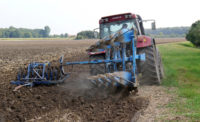Long hours of sitting on machinery and working in uncomfortable positions, like kneeling and crawling, along with lifting heavy loads can lead to injuries for farmers. Because of such physically demanding environments, farmers have a greater risk than workers in many other industries of experiencing musculoskeletal disorders—soft-tissue injuries from frequent motion, force, and awkward positions—especially low back pain.
A common risk factor for soft-tissue injuries is whole body vibration, defined as mechanical jolts felt throughout the body when using machines. Currently, little research is available on farmers’ exposure to whole body vibration when using different types of machinery. To address this issue, a National Institute for Occupational Safety and Health (NIOSH)-funded study at the University of Iowa measured trunk posture and used devices called sensors to measure whole-body vibration as a group of farmers operated 112 agricultural machines. The machines included tractors, combines, heavy utility vehicles like forklifts, and all-terrain vehicles. The researchers compared their measurements to the European Union’s whole-body vibration exposure limits, defined as a cutoff point above which vibration levels increase health risks.
All of the machines exhibited high vibrations levels within an average of a half hour of use, although measurements varied, according to the study in the Annals of Work Exposures and HealthExternal. In fact, within 2 hours, nearly 30% of the machines exceeded the European Union’s whole-body vibration exposure limits. All-terrain vehicles had the highest measured vibration levels, and combines had the lowest, which could be due to the weight of the machine and seat-based suspension systems, according to the researchers. For most of the machines, the seat reduced whole-body vibration levels to some extent. Seat-based suspension systems, however, did not substantially decrease whole-body vibration for tractors when compared to tractors without this equipment. The tractors’ seat-based suspension systems may not have been properly adjusted to the farmers’ weight, or they could have worn out over time, according to the researchers. These machines had average vibration levels twice that of combines.
The study included 55 farmers—a subset of 518 farm operators participating in long-term research on physical risk factors and musculoskeletal pain among Midwestern agricultural workers. Most of the study participants were male with an average age of 58 years and reported working in agriculture for an average of 38 years.
The study’s findings could be underestimates, in part, because the researchers did not collect measurements the entire time of machine operation. For this and other reasons, the researchers recommend future studies that measure whole body vibrations during machinery use at different times of the day.
More information is available:
- Whole-Body Vibration and Trunk Posture During Operation of Agricultural MachineryExternal
- UI study looks at ag machinery vibration, back pain among farmersExternal
- NIOSH Extramural Research and Training Programs: Centers for Agricultural Safety and Health
- NIOSH Extramural Research and Training Programs: Education and Research Centers
- CDC Work-Related Musculoskeletal Disorders & Ergonomics
- Great Plains Center for Agricultural HealthExternal
- Heartland Center for Occupational Health and SafetyExternal


